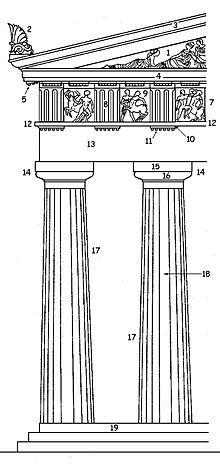Sima (architecture)
This article does not cite any sources. (December 2007) |


In classical architecture, a sima is the upturned edge of a roof which acts as a gutter. Sima comes from the Greek simos, meaning bent upwards.
Form[]
The sima runs around all four sides of a building. The raking sima is continuous, while the simas on the other sides are broken by downspouts. Early simas feature tubular or half-cylindrical spouts, but these were mostly replaced with animal-head spouts by the middle of the 6th century BC.
Simas may be made of terracotta or stone.
Decoration[]
Simas are normally decorated. Stone simas have continuous narratives, especially on the raking sides where they are not interrupted by spouts, similar to a frieze. Terracotta simas have repeating patterns that are easy to reproduce with molds.
External links[]
![]() The dictionary definition of sima at Wiktionary
The dictionary definition of sima at Wiktionary
- Ancient Greek architecture
- Roofs
- Architectural element stubs